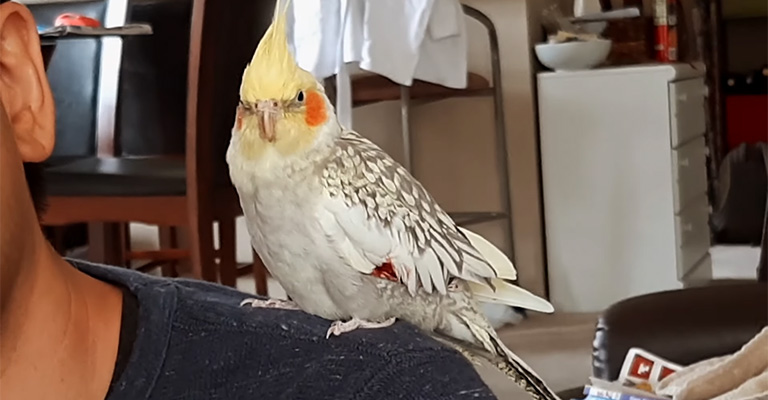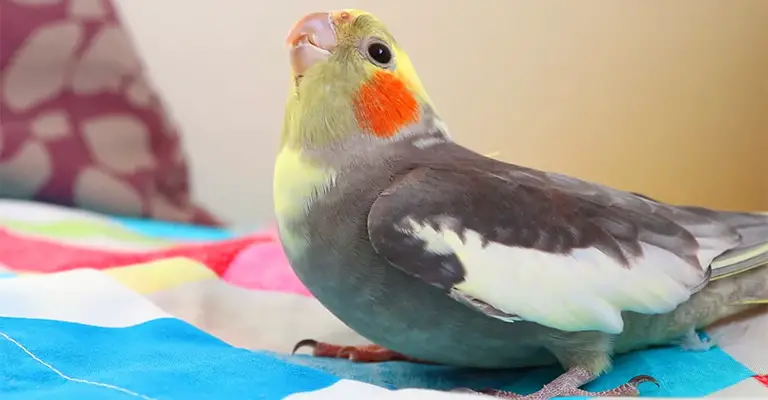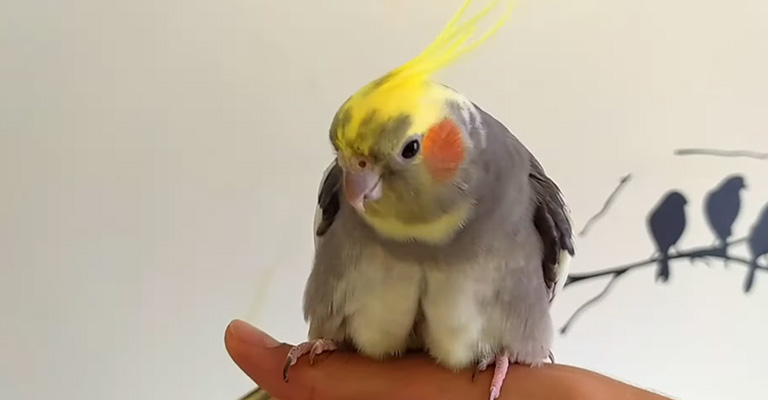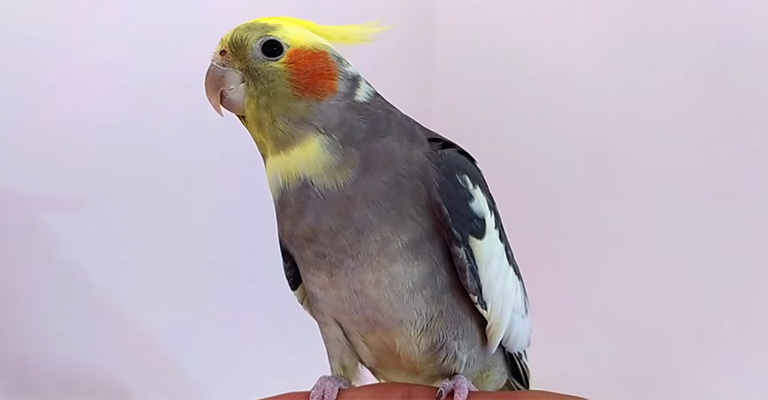The graceful and charismatic cockatiel, known for its distinctive crest and vibrant plumage, can experience a range of health concerns, including tail feather loss.
The regrowth of a cockatiel’s tail feathers is a topic of interest for avian enthusiasts and caretakers alike.
Understanding cockatiel’s tail grow back- cause, diagnosis, and treatment options for tail feather loss in cockatiels is crucial for ensuring their overall well-being.
Whether due to molting, injury, or underlying health issues, the regrowth process sheds light on the resiliency of these beloved avian companions.

Cockatiels Tail Grow Back- Cause
Cockatiels are beautiful and intelligent birds that have long and graceful tail feathers. However, sometimes they may lose some or all of their tail feathers due to various reasons.
Here are some of Cause:
Molting
This is the natural process of shedding old feathers and growing new ones, usually once or twice a year.
Molting is normal and healthy for cockatiels, and it helps them maintain their plumage and hygiene. During molting, cockatiels may lose some of their tail feathers, but they will grow back in a few weeks.
Accidents
This is when cockatiels lose their tail feathers due to external factors, such as falls, collisions, or entanglements. Accidents can happen when cockatiels are flying, playing, or exploring their environment.
Sometimes, cockatiels may break or pull out their tail feathers to free themselves from a sticky situation.
Accidents can cause pain and bleeding for cockatiels, but their tail feathers will usually grow back in a few months.
Stress

This is when cockatiels lose their tail feathers due to psychological factors, such as fear, anxiety, or boredom.
Stress can be caused by factors such as noise, predators, changes in the environment, or lack of stimulation or interaction.
Stress can affect the health and behavior of cockatiels and make them lose their appetite, sleep, and confidence. Stress can also make cockatiels pluck or bite their own feathers, including their tail feathers.
Stress can be hard to treat for cockatiels, but their tail feathers may grow back if the source of stress is removed or reduced.
Illness
This is when cockatiels lose their tail feathers due to physical factors, such as infections, parasites, injuries, or diseases.
Illness can affect the immune system and metabolism of cockatiels and make them lose their energy and vitality. Illness can also affect the quality and growth of their feathers and make them dull, brittle, or deformed.
Illness can be serious and life-threatening for cockatiels, and they may need veterinary care and medication to recover. Illness can delay or prevent the growth of new tail feathers for cockatiels.
Diet
This is when cockatiels lose their tail feathers due to nutritional factors, such as deficiency, excess, or imbalance of vitamins, minerals, proteins, fats, or carbohydrates.
Diet can affect the health and development of cockatiels and make them more susceptible to illness or stress.
Diet can also affect the color and texture of their feathers and make them faded, frayed, or sparse.
Diet can be easily improved for cockatiels, and they may need a balanced and varied diet that includes fresh fruits, vegetables, seeds, nuts, pellets, and occasional treats. Diet can enhance or restore the growth of new tail feathers for cockatiels.
Genetics
This is when cockatiels lose their tail feathers due to hereditary factors, such as genes or mutations.
Genetics can determine the size, shape, color, and pattern of cockatiels’ feathers, as well as their susceptibility to certain diseases or conditions that affect their feathers.
Genetics can also cause some rare abnormalities or deformities in cockatiels’ feathers, such as curled or split feathers. Genetics cannot be changed for cockatiels, but they may need special care and attention to cope with their genetic issues.
Age

This is when cockatiels lose their tail feathers due to natural factors, such as aging or senescence. Age can affect the lifespan and function of cockatiels’ cells and organs and make them more prone to illness or stress.
Age can also affect the production and quality of their feathers and make them thinner or weaker. Age cannot be reversed for cockatiels, but they may need extra care and comfort to enjoy their golden years.
Mating
This is when cockatiels lose their tail feathers due to behavioral factors, such as mating or breeding. Mating can be a natural and healthy activity for cockatiels that are sexually mature and compatible.
However, mating can also cause some problems for cockatiels’ feathers, such as damage from biting or pulling by their partner or offspring.
Mating can also cause hormonal changes in cockatiels that affect their feather growth and molt cycle.
Hybridization
This is when cockatiels lose their tail feathers due to artificial factors, such as human intervention or manipulation.
Hybridization is the process of creating new breeds or varieties of cockatiels by crossing different species or strains. Hybridization can produce some unique and attractive features in cockatiels, such as new colors or patterns.
However, hybridization can also cause some undesirable or harmful effects in cockatiels, such as infertility, sterility, or deformity. Hybridization can also affect the growth and appearance of their feathers and make them shorter or longer.
These are some of the causes of cockatiels’ tail feathers falling out, but there may be other reasons that affect different birds in different ways.
The best way to prevent or treat feather loss in cockatiels is to provide them with a safe, comfortable, and fun environment, a balanced and nutritious diet, regular and positive interaction, and veterinary care when needed.
Cockatiels Tail Grow Back- Diagnosis

Cockatiels are beautiful and intelligent birds that have long and graceful tail feathers. However, sometimes they may lose some or all of their tail feathers due to various reasons.
To diagnose the cause and the treatment of your cockatiel’s feather loss, you need to consider some factors, such as:
Feather Molt
Molting is a natural process where cockatiels shed old feathers and grow new ones. During this period, tail feathers might fall out as part of the normal regrowth cycle.
The appearance of new pin feathers, which are covered in a protective sheath, indicates ongoing molting.
Plucking By Other Birds
In a shared aviary or multi-bird household, dominant birds may pluck the tail feathers of their companions.
This behavior can stem from territorial disputes or social hierarchy. Observing interactions among birds can help diagnose this issue.
Self-Plucking Or Feather Picking
Cockatiels can engage in self-plucking due to stress, boredom, or health problems. If the tail feathers are frayed, uneven, or entirely missing, self-plucking might be the cause. Identifying the underlying cause of stress is essential for treatment.
Nutritional Imbalances
A lack of proper nutrients, particularly vitamins, and minerals like calcium and protein, can lead to feather problems, including tail feather loss. A veterinarian can conduct blood tests to identify nutritional deficiencies.
External Parasites
Mites or lice infestations can irritate a cockatiel’s skin, leading to feather loss. Careful observation of the skin and feathers, along with veterinary diagnosis, can confirm the presence of external parasites.
Infections or Diseases
Various infections, including bacterial, fungal, and viral, can lead to feather abnormalities. A thorough examination by an avian veterinarian, possibly including tests and cultures, is necessary to diagnose and treat these conditions.
Environmental Stress
Changes in the environment, such as sudden temperature fluctuations, noise, or the presence of predators, can stress cockatiels and trigger feather loss. Identifying and addressing these stressors can aid in tail feather regrowth.
Hormonal Changes
Hormonal fluctuations, especially during the breeding season, can influence a cockatiel’s behavior and feather condition.
Understanding the hormonal changes and providing a stable environment can help prevent excessive feather loss.
Medical Conditions
Certain medical conditions like organ dysfunction or tumors can indirectly affect feather health. A comprehensive avian vet checkup can identify underlying medical issues that might be contributing to tail feather loss.
Identifying the correct diagnosis behind a cockatiel’s tail feather loss is crucial for effective treatment. Consulting an avian veterinarian is recommended to ensure proper care and management tailored to the specific underlying cause.
Cockatiels Tail Grow Back- Treatment

Here are some possible treatments for your cockatiel’s feather loss:
Trimming
This is when you cut off the damaged or broken feathers to encourage new growth. Trimming can help prevent further damage or infection to the feathers and make them look neater and cleaner.
You should use sharp scissors and only trim the tips to avoid injuring your cockatiel. You should also avoid trimming too many feathers at once to prevent stress or shock to your cockatiel.
Nutrition
This is when you provide your cockatiel with a balanced and nutritious diet to promote healthy feather growth. Nutrition can help improve the quality and color of your cockatiel’s feathers and make them more resistant to damage or disease.
You should feed your cockatiel a variety of fresh fruits, vegetables, seeds, nuts, pellets, and occasional treats. You should also provide your cockatiel with clean and fresh water that is free of chlorine, fluoride, or other chemicals.
Grooming
This is when you regularly groom your cockatiel’s feathers to prevent feather plucking or biting. Grooming can help keep your cockatiel’s feathers clean and smooth and make them more comfortable and attractive.
You should gently brush or comb your cockatiel’s feathers with a soft brush or comb. You should also mist or bathe your cockatiel with lukewarm water to remove any dirt or dust from its feathers.
Stimulation
This is when you provide your cockatiel with plenty of toys and activities to prevent boredom or stress. Stimulation can help keep your cockatiel entertained and curious and reduce its tendency to pluck or bite its feathers.
You should offer your cockatiel different types of toys that are safe and suitable for their size and personality. You should also rotate the toys regularly to keep them interesting and challenging for your cockatiel.
Interaction
This is when you spend time with your cockatiel every day to prevent loneliness or depression. Interaction can help satisfy your cockatiel’s social needs and make it feel more loved and secure.
You should talk to your cockatiel often using simple words or phrases that it can learn and repeat. You should also play with your cockatiel using toys or games that are fun and stimulating for both of you.
Medication
This is when you give your cockatiel medicine to treat any illness or infection that may cause feather loss. Medication can help cure or control the symptoms of the disease and restore your cockatiel’s health and vitality.
You should consult a veterinarian before giving any medication to your cockatiel, as some drugs may be harmful or ineffective for birds.
You should also follow the instructions carefully on how to administer the medication to your cockatiel.
Supplements
This is when you give your cockatiel supplements to boost its immune system and metabolism. Supplements can help improve your cockatiel’s overall health and well-being and make it more resilient to illness or stress.
You should consult a veterinarian before giving any supplements to your cockatiel, as some products may be unnecessary or excessive for birds. You should also follow the directions carefully on how to give the supplements to your cockatiel.
Lighting
This is when you provide your cockatiel with adequate amounts of natural or artificial light to regulate its circadian rhythm and molt cycle.
Lighting can help synchronize your cockatiel’s biological clock and hormones and influence its feather growth and development. You should expose your cockatiel to at least 10 hours of light and 14 hours of darkness per day.
You should also use full-spectrum or UV lights that mimic the sun’s rays and benefit your cockatiel’s vision and feather color.
Surgery
This is when you take your cockatiel to a veterinarian for a surgical procedure to correct any abnormality or deformity in its feathers. Surgery can help fix any problems that may prevent your cockatiel from growing new feathers or make its feathers look unnatural or unhealthy.
You should only consider surgery as a last resort, as it can be risky and expensive for your cockatiel. You should also follow the post-operative care instructions carefully to ensure your cockatiel’s recovery and comfort.
These are some of the possible treatments for your cockatiel’s feather loss, but there may be other options that suit your cockatiel’s needs better.
The best way to treat your cockatiel’s feather loss is to provide it with a safe, comfortable, and fun environment, a balanced and nutritious diet, regular and positive interaction, and veterinary care when needed.
FAQ
Cockatiels can lose tail feathers due to normal molting, accidental plucking, or health issues like malnutrition or stress. Identifying the cause is essential for proper treatment.
Molting is a natural process where old feathers are shed and replaced with new ones. Look for signs of new feather growth and ensure your cockatiel’s overall behavior remains normal.
If tail feathers don’t regrow after molting or there’s excessive feather loss, it’s wise to consult a veterinarian. Tail feather loss can sometimes indicate underlying health issues that need attention.
Yes, stress, such as changes in the environment or lack of mental stimulation, can trigger feather plucking or loss. Identifying and addressing the source of stress is crucial for tail feather regrowth.
Separate birds if necessary to prevent further plucking. Provide a calm environment, and consult an avian veterinarian for guidance on treating any injuries and promoting tail feather regrowth.
Conclusion
The process of a cockatiel’s tail feather regrowth, while natural, can be influenced by a variety of factors, including molting cycles, injuries, and health conditions.
As caretakers, it’s vital to provide proper nutrition, a stress-free environment, and regular veterinary checkups to support healthy feather regrowth. Patience is key, as the process can take time.
By understanding the causes and seeking professional guidance if necessary, we can ensure that our cockatiel companions thrive and display their vibrant plumage once more, a testament to the intricate interplay of biology and care in the avian world.